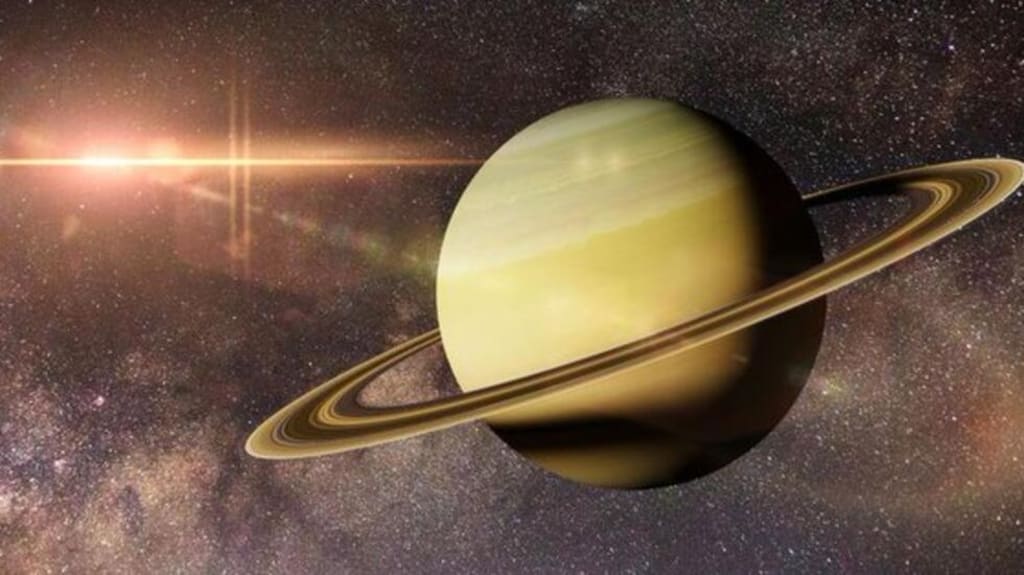Something Strange Is Happening on Saturn, Scientists Are at a Loss.
Something Strange Is Happening on Saturn

Do you recognize this majestic world, the second-largest planet from the sun, a gas giant with a hazy yellow-brown appearance and seven huge intimidating rings? You're right; it can't be anything else but Saturn. Recently, the Hubble Space Telescope has made an astonishing discovery that adds another layer to the mysteries of this captivating celestial giant. The planet's iconic rings, it seems, are not just a breathtaking sight—they are actively influencing and heating Saturn's upper atmosphere.
A recent study based on observations from the Hubble Space Telescope, retired Cassini probe, and Voyager 1 and 2 spacecraft has revealed a previously unnoticed phenomenon. These iconic rings, which have been captivating astronomers for over 40 years, are playing a role in heating Saturn's upper atmosphere. What's even more intriguing is that NASA researchers claim this interaction is unique and has not been observed anywhere else in our solar system.
This remarkable discovery remained hidden in plain view for decades until astronomers analyzed data from the Hubble Space Telescope, retired Cassini probe, and Voyager spacecraft. The unexpected interaction between the gas giant and its rings not only sheds light on Saturn's mysterious dynamics but also provides a potential tool for identifying similar ring systems around planets in other star systems.
The telltale evidence of this unseen interaction lies in an excess amount of ultraviolet radiation, specifically in the form of a spectral line of hot hydrogen in Saturn's atmosphere. The observation reveals a noticeable bump in radiation, indicating an external heat source influencing the upper atmosphere. While the exact process remains unclear, scientists propose that icy ring particles raining down on Saturn could be the cause. Alternatively, the impact of tiny meteorites or solar wind particles might contribute to this intriguing heating phenomenon.
NASA's Cassini probe, before concluding its mission by plunging into Saturn's atmosphere, provided valuable insights into the atmospheric components. It confirmed that numerous particles were indeed falling from Saturn's rings, contributing to the heating process under the influence of the gas giant's gravitational field.
Saturn, known for the slow disintegration of its rings, has now presented scientists with the challenge of understanding how this process affects the planet itself. The gas giant's rings, once considered mere adornments, are now recognized as active contributors to the planet's atmospheric dynamics.
Delving further into Saturn's mysteries, astronomers have studied its magnetosphere—the enormous magnetic bubble produced by forces deep within the planet. This protective shield influences the interaction between the solar wind's electrically charged particles and Saturn's magnetic field. Despite having limited visibility into Saturn's magnetosphere due to its invisible magnetic fields, astronomers believe it plays a crucial role in shielding the gas giant from the sun's harmful particles.
Saturn's auroras, caused by energetic winds from the sun, differ from Earth's in that they can only be observed in ultraviolet light. These spectacular displays, invisible from Earth's surface, are a consequence of Saturn's tilted axis and the planet's own atmospheric dynamics.
One of Saturn's most intriguing features is the mysterious vortex swirling over its South Pole. Resembling an enormous hurricane-like storm, this stationary vortex defies the characteristics of a typical hurricane on Earth. Unlike terrestrial hurricanes, Saturn's vortex is warm, and its stationary nature, coupled with its enormous size, continues to baffle astronomers.
Another surprise from Saturn comes in the form of shadowy spokes observed on the left side of the planet's rings. Captured by the Hubble Space Telescope, these dark features, informally called "spokes," vary in shading and shape. Astronomers believe they might be linked to Saturn's magnetic field, creating an electrically charged environment that temporarily levitates icy ring particles.
The upcoming equinox on May 6, 2025, promises more revelations as Saturn's rings align edge-on to the sun. This alignment might further elucidate the origin and characteristics of these enigmatic spokes, adding another layer to our understanding of Saturn's intricate dynamics.
Saturn's rings, once considered static and purely aesthetic, have emerged as dynamic players influencing the gas giant's atmosphere. As scientists continue their long-term monitoring of Saturn and its rings, the secrets hidden in the cosmic dance of this captivating celestial body are slowly unfolding.
So, as we gaze at the second-largest planet from the sun, let's appreciate the complexity and beauty that Saturn brings to our cosmic neighborhood. If this cosmic journey has fueled your curiosity, don't forget to like and share the video. Stay tuned for more cosmic revelations, and keep exploring the wonders of the bright side!
About the Creator
Enjoyed the story? Support the Creator.
Subscribe for free to receive all their stories in your feed. You could also pledge your support or give them a one-off tip, letting them know you appreciate their work.





Comments (2)
Very well written
This article is fantastic